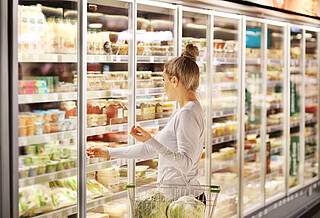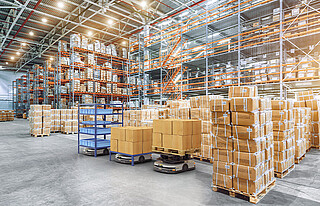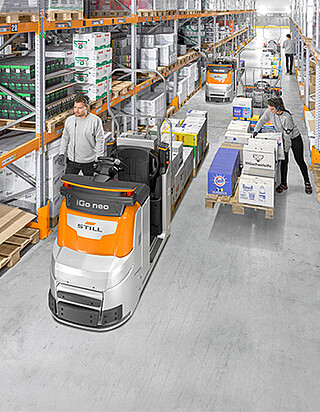Flexible and effective
The retail sector places high demands on logistics: online customers and local shops must be supplied in equal measure and, in addition, the goods are diverse and in some cases perishable.

Ordered on Monday and delivered by Tuesday. What seemed utopian ten years ago is now reality. Consumers are used to not having to wait long for their goods, that everything is available very quickly, be it online or in the shop. For retailers, this expectation is a daunting task. After all, customers do not necessarily buy more, but they do expect an extensive assortment and many choices. This requires restructuring, both in the shop and in the warehouse. Even to have one's own online shop is often a prerequisite. Therefore, retailers are not only concerned with the question of how to get the goods into their shop, but also with how to get them directly to the customer's home.
Multiple sales channels
Depending on the goods on offer, various sales models have also evolved, some of which combine online and local trade. When it comes to electrical appliances, for example, consumers prefer to get information online first, but then go to the shop to make a purchase. If they do buy the new washing machine or the new laptop online, they also like to order directly from the manufacturer. By contrast, shoppers are divided when it comes to buying textiles: Around 50 per cent prefer to buy clothes or bed linen in a shop, the other half prefer to buy online. A trend towards online retailing is also evident in the food sector. For food retailers, however, the requirements for storage and transport are much higher, as some goods are perishable and in some cases need to be refrigerated.
All these trends place special demands on intralogistics in the retail sector. STILL summarises the key challenges facing the industry in its latest white paper, 'Retail & Wholesale'. The publication also outlines the solutions and new technological developments for logistics that the company has in its portfolio.

Automation in the warehouse
Even though the fully automated and autonomous warehouse from goods receipt to goods issue does not yet exist, cooperating robotic systems have long been established. These technologies are used especially for order picking in the warehouse. The range includes vehicles that follow the order pickers, those that show the way, and Autonomous Mobile Robots (AMR) that autonomously transport shelves with goods to a fixed location for order picking. The actual picking of goods is still difficult for the robots - especially when the products do not all have the same dimensions. As there are still no sufficiently mature technical solutions, human employees are still needed for this.

In the long term, this also means that humans and robots will work together in the same space. STILL's OPX iGo neo horizontal order picker is an example of cooperative robotics: the truck is able to make decisions on its own and avoid obstacles or stop. It follows an assigned operator, eliminating about a third of the mounts and dismounts as well as manual driving to the next picking position, which otherwise cost time and energy. This increases picking performance and reduces picking errors.
While order picking is the most detailed step in retail logistics, employees also receive technical support in other areas: the modules of the STILL material flow management system make it possible to control all flows of goods and information along the entire intralogistics chain. In the system solution, all hardware and software components from STILL are modular and coordinated with each other. This enables continuous monitoring of the goods across several warehouses and efficient assignment of the industrial trucks and employees.

New transport routes
Until now, the responsibility of logistics providers ended as soon as the goods arrived at their destination - whether in the shop or at the end customer's home. However, this might change in the future: it is already common for food deliveries that suppliers bring reusable packaging and boxes back from the end customer to the warehouse. Such transport routes are likely to become even more important when it comes to making the transport chain increasingly sustainable. The return and disposal of old electrical appliances is also increasingly becoming the responsibility of retailers. Up to now, the flow of goods has mostly been designed for a linear supply chain - this is where the industry needs to react and find new solutions.

The examples above show that the demands on retail logistics will continue to rise. On the one hand, customers have become more flexible with regard to distribution channels, but they are also more impatient. The smooth flow of goods transport is increasingly becoming a prerequisite for successful retailing. Read more about this topic in the new STILL white paper "Retail & Wholesale".
Contact request
Subscribe to the Newsletter !
Always up to date with STILL: Subscribe to the STILL newsletter and we will inform you regularly about interesting industry topics.
